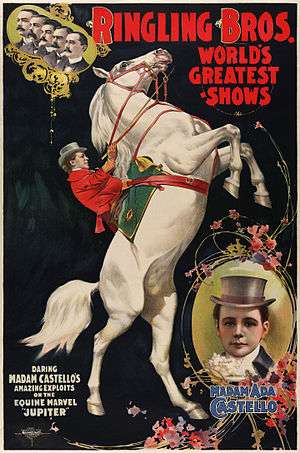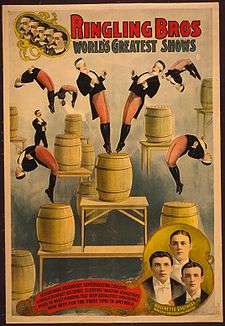Ringling Brothers Circus
| Ringling Bros. World's Greatest Shows | |
|---|---|
 Poster for Ringling Bros. World's Greatest Shows, ca. 1899 The Ringling brothers depicted in the upper left corner | |
| Origin | |
| Circus name | Ringling Bros. World's Greatest Shows |
| Country | United States |
| Founder(s) | The Ringling Bros. |
| Year founded | 1884 |
| Information | |
| Operator(s) | Ringling Bros. |
| Fate | Merged with Barnum & Bailey's Greatest Show on Earth |
| Website | https://www.ringling.com |
The Ringling Bros. World's Greatest Shows was a circus founded in the Founded in Baraboo, Wisconsin, United States in 1884 by five of the seven Ringling Brothers: Albert, August, Otto, Alfred T., Charles, John), and Henry. The Ringling brothers were sons of a German immigrant, August Frederick Rungeling, who simplified his name to to Ringling once in America. In 1907 Ringling Bros. was acquired by the Barnum & Bailey Greatest Show on Earth, merging them in 1919 to become Ringling Bros. and Barnum & Bailey Circus, promoted as The Greatest Show on Earth.[1]
History



In 1882, before the Ringling brothers created their first circus, the 5 brothers performed skits and juggling routines in town halls around the state of Wisconsin. There first show was on November 27, 1882, in Mazomanie, Wisconsin. They called this the "Ringling Bros. Variety Performance" when they took the show to the next town. With two wandering performers the next year, the brothers toured the Northwest. After the Northwest tour, they used the money earned for suits.[2]
They expanded their acts into a one ring show in 1884. The show added a trick horse and a bear at the end of the season. The circus started traveling by trains in 1888 allowing the show to consistently expand.[2]
The Ringling Circus purchased the Yankee Robinson Circus and open a join show on May 19, 1884. This brought them to the attention of James Anthony Bailey of Barnum and Bailey's Circus as a viable competitor. The brothers met with Bailey thus agreeing to a division of areas. This was followed by them purchasing a 1/2 share of the Adam Forepaugh Sells Brothers Circus circus from Bailey. Bailey, under the area division, nixed the Ringlings from playing at the Madison Garden, a location that was the brother's ambition to perform at. In 1887 Ringling Circus change its official title to the "Ringling Bros. United Monster Shows, Great Double Circus, Royal European Menagerie, Museum, Caravan, and Congress of Trained Animals."[2]
In 1906, Bailey died which led to the Ringlings taking over Forepaugh-Sells, which continued to operate separately. In October 1907, the stockholders of Barnum and Bailey's Circus approved the sale of the circus to the Ringlings.[2]
Taking the promotion title of the Circus, a 1952 drama film was made using the Circus, called The Greatest Show on Earth. The film was produced and directed by Cecil B. DeMille. The film was shot in Technicolor and released by Paramount Pictures. The setting of the film was the Ringling Bros. and Barnum & Bailey Circus. The film starred Betty Hutton and Cornel Wilde as trapeze artists competing for the center ring. Also Charlton Heston as the circus manager running the show. James Stewart starred in a supporting role as a mysterious clown who never removes his make-up, even between shows and Dorothy Lamour and Gloria Grahame play supporting roles.[3][4] [5]
See also
- Trapeze a 1956 film with technical consultant from Ringling Brothers Circus.
External links
References
- ↑ Wisconsin History, Historical Essay, Ringling Brothers: The Beginnings of the 'Greatest Show on Earth
- 1 2 3 4 "Augustus Ringling Dead. Head of Tented Shows In America Dies in New Orleans." (PDF). New York Times. August 19, 1907. Retrieved 2008-07-20.
When the Ringling Brothers bought the Barnum Bailey show they ... got a monopoly on the circus business in America. They now own outright three ...
- ↑ "The Greatest Show on Earth (1952)". Box Office Mojo. Retrieved August 17, 2016.
- ↑ The Greatest Show On Earth, a January 2, 1952 review from Variety
- ↑ De Mille Puts Greatest Show on Earth on Film for All to See, a January 11, 1952 review from The New York Times
